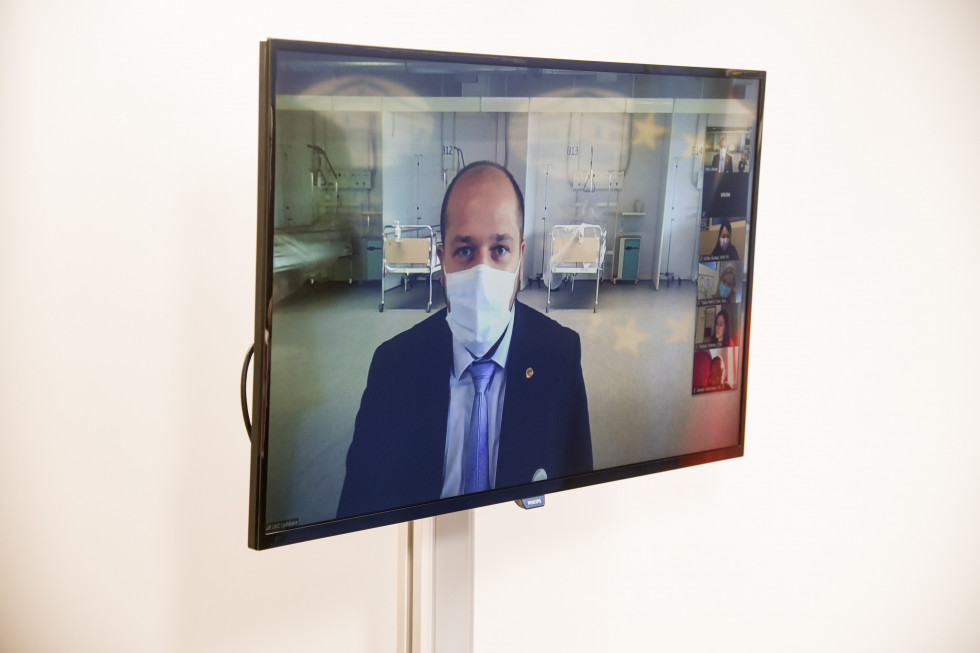Poklukar: The de-escalation of the situation in hospitals should be the criterion to start easing the measures

General Manager of Ljubljana University Medical Centre Janez Poklukar | Author Nebojša Tejić, STA
With 2,063 tests performed on Sunday, 464 were positive, which amounts to 22.49 per cent. Some 24 people died, 18 in hospitals and six in retirement homes. Yesterday, 1,143 patients were in hospitals, which is 18 more than on Saturday and 190 patients required intensive care, i.e. 14 more than the day before.
The 14-day incidence rate at the state level per 100,000 inhabitants was 1,096 on Friday, and the number of positive cases reduced by 1,027 yesterday. This places us fourth among the European countries, preceded by the Czech Republic, Luxembourg and Belgium, and followed by France, Croatia and Austria.
According to Poklukar, 291 patients are being treated at Ljubljana University Medical Centre, of whom 59 are in intensive care. Some 45 patients are being treated via telemetry in their home environment.
The establishment of additional COVID-19 facilities at the premises initially foreseen to be used by the diagnostic and therapeutic services (DTS) is very valuable since they are located within Ljubljana University Medical Centre, which results in many advantages due to the concentration of numerous experts and equipment. When the number of hospitalised patients starts decreasing, Ljubljana University Medical Centre will concentrate here all patients from the currently dislocated facilities at their other clinics in addition to the accommodation at the Clinic for Infectious Diseases and Febrile Illnesses.
The provider’s initial bid to construct the facilities was EUR 2.4 million; the final agreed price amounted to EUR 2.3 million, i.e. EUR 2.9 million including VAT. Furthermore, EUR 1 million was earmarked for equipment. The investment thus totals EUR 3.3 million. Some equipment was also borrowed from civil protection forces.
The first patients will be accommodated at the premises today, and after the end of the epidemic, the premises will be used for their initial purpose.
Poklukar admitted that the decision to renovate the premises was made too late. He illustrated that the capacity plans for the second wave of the epidemic expected a two- to threefold increase in the capacities, or up to fivefold in the worst case scenario. The highest daily number of patients hospitalised amounted to 54 in the first wave, and now they have 291 patients, which is more than a sixfold. When faced with the increasing of the second wave towards the threshold of a fivefold, they reacted and decided to renovate the DTS facilities.
The lack of staff is being addressed by reassignment of 510 employees from other departments to the COVID-19 departments. They currently record 288 employees with COVID-19 and 180 are additionally quarantining. None of the latter is working and they will further comply with this rule.
The Director particularly highlighted that only a slight reduction in the implementation of activities in other programmes was recorded in October since the scope of work reduced by merely up to no more than 20 per cent, which is very agreeable and they wish that such scope would also be attained in November.
They are against easing of the measures until the situation starts calming in hospitals, which should be the essential criterion for the decision-makers, stated Poklukar.
Kacin emphasised in the end that the Expert Group at the Ministry of Health would in the middle of this week decide about the (non)extension of measures in schools next week. The Minister of Education, Science and Sport will speak to primary school head teachers via a video conference and try to promptly resolve the issues regarding the implementation of remote learning.

